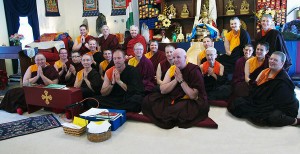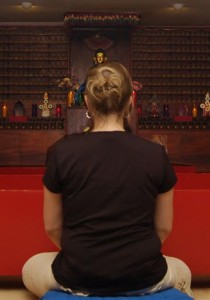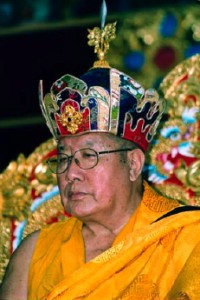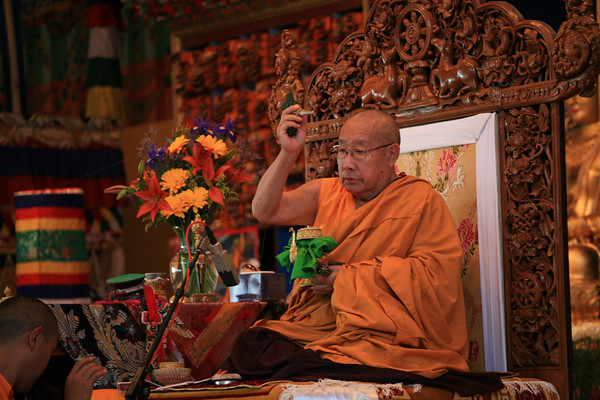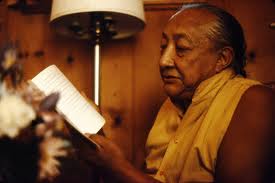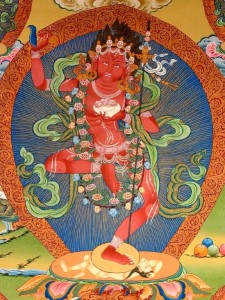The following is an excerpt from a teaching by Jetsunma Ahkon Lhamo called “Reclaiming Our Merit”
This is a really difficult time, not only for the Sangha, but it’s really a direct reflection of what we’re seeing on our planet right now. There is corruption in business and government like I’ve never seen before. Many of us have become professional samaya breakers, meaning that we have not kept our commitments and, in many cases, have dropped our robes, or whatever. And because we are lost in samsara, we simply don’t understand cause and effect. Not only are they connected, but they arise interdependently. Time and space is our delusion. Cause and effect arise at the same instant.
So exacting is cause and effect. Yet we have not really milked the essence out of that understanding so that we can create better lives for ourselves, or practice for ourselves and make a deeper commitment for ourselves. We simply have not utilized what we have received. And here in this time, you don’t know where to look, left or right. What is pure, what is sacred, what is wholesome? All of it seems to be confused and dark; and right now our hearts are heavy. We were so innocent when we were younger, and some of you that are still young are still innocent, so innocent thinking that can never happen to us. So learn.
In this time of debilitating darkness and confusion, we have to strengthen ourselves. I’ve had students propose the question to me: What is the benefit of the robes? I look around at you and I say to myself, ‘Aren’t you terrified to be without them?’ Well you should be, because these robes now are like a shield of virtue. You are what we have. The power of the Buddha’s blessing is such and the robes are so potent that a quorum is considered four ordained monks and nuns with yellow robes. That quorum has the power and the stamp of the Buddha’s blessing. We can get four other people together and you won’t have the same conditions. And even knowing that, we barely use it. It’s so powerful. It’s such refuge in these dark times. And yet we don’t call up three of our friends and say, ‘Hey, you know, let’s get together and pray for the world. Or maybe we should get together and pray for our Sangha.’
You have, on your bodies, the most excellent and extraordinary tool one can have in this time other than realization and giving rise to the bodhicitta. If you think somehow that compassion and realization and awakening are separate, you are fooling yourself because they are the same essence, the same taste.
We are approaching this really dark time, where lamas are sick, things are happening to people that we know and love; monks and nuns that we had great hope for, great hope for, have gone. And so what are we left with? We are left with this. How many lifetimes do you think it took you to earn wearing these robes? And for those of you who are in the halfway step, wearing your red and white robes, I appreciate that, too. The genyen population and the genyen Sangha, myself included, having been genyen for many lifetimes, many lifetimes, this is a support. But the real princes and queens of our Sangha, our Dharma, this is the ordained community. The more often you get together with your yellow robes and make prayers together with depth and honesty and true compassion; and seeing what is happening in this world, give rise to that compassion in a certain way, the power that you wield is phenomenal. But we’re kind of like this: ‘Oh, I can’t do it. Oy, oy, oy.’ We suddenly all became Jewish. Oy, oy, oy. I’m half Jewish. I can say it.
But that’s how we are. We got into kind of crying, kind of whining like babies. We have so much power if we will only utilize it with faith. The reason I wanted to talk about that is because it’s important that you guys who are ordained have real confidence in the fact that you are wearing the Buddha’s robes. You have to think, ‘I have this jewel. I have this nourishment that I can pass on and give to others.’ I want you to be cognizant of the power of the commitment that you keep. And you must keep it squarely and purely in order for it to provide for you the protection and nourishment that you need. So as far as I am concerned, the ordained community are the nectar of what we can do here. I would love to see you all take more initiative in practicing together and understanding that four is a quorum and that you can change things.
And even beyond that, I want to talk about not only the corruption of this time and the darkness of this time, but I’d like to say that this time has been predicted and taught about and we knew it was coming and nobody believed. This is the time when even the most profound Dzogchen teachings are passed out like candy; and I’m afraid it’s often passed out like seeds thrown onto cement. And why is that the case? Well, lamas predicted when the conditions might be right to give Dzogchen teachings, so you either get them or you don’t. You get them based on the capacity and generosity and accumulated virtue of the lama, or you don’t get them.
And the reason why this is happening is because we haven’t bothered to create the foundation upon which these kinds of practices, wisdoms and awarenesses are built. And if they are practiced with no foundation, there is no result. You are at the circus. You are seeing phenomena in your head. And once phenomena is perceived, you’re off. You’re lost without a compass.
